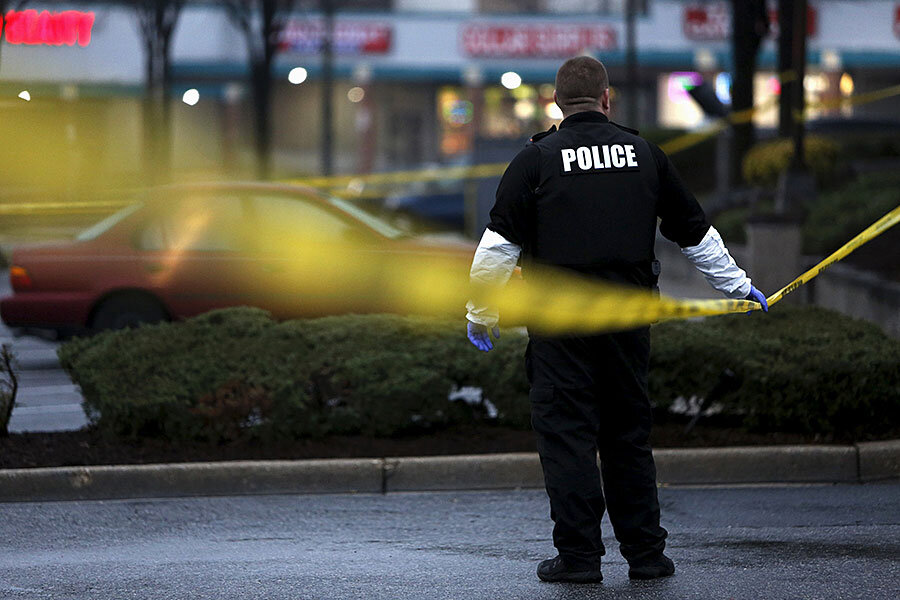Can this tracking system help reduce police shootings?
Loading...
Homicides by law enforcement officers across the United States are recorded far more accurately in a nascent system of the US Centers for Disease Control and Prevention (CDC) than by current national systems, according to new research.
The paper, published Thursday in the American Journal of Public Health, compares the CDC’s system, which currently covers only 32 states, with two national ones – one of the FBI and another of the CDC itself – finding it provides not only more accurate numbers, but also a far richer picture of the circumstances surrounding each incident.
At a time of heightened public awareness of police shootings, it becomes particularly important to identify the system best able to paint an accurate picture, allowing policymakers to understand which programs help to reduce fatalities.
“What’s important is building public trust and showing what we can do to help reduce this problem,” says James Mercy of CDC, in a telephone interview with The Christian Science Monitor.
Dr. Mercy, who heads the Division of Violence Prevention in the National Center for Injury Prevention and Control at CDC, explains that NVDRS, the system lauded by the research paper, links data from law enforcement records, death certificates, and medical examinations and coroners.
As such, it is able to “create narratives” as to the events surrounding each incident, building a much richer picture of police homicides, and violent deaths in general.
Moreover, the system looks not only at killings by police, but also police killed in the line of duty, allowing CDC to look at “both sides of the equation.”
“The troubling reality is that we lack the ability right now to comprehensively track the number of incidents of either uses of force directed at police officers or uses of force by police,” said Attorney General Eric Holder in January 2015.
It is this very situation, and the controversy surrounding recent high-profile police killings, that led the researchers to undertake their study.
“How do we learn which policies best prevent these deaths and protect police if we can't even get an accurate count of them?” asked lead author Catherine Barber in a press release.
Ms. Barber and colleagues of the Harvard Injury Control Research Center (HICRC) at Harvard's T.H. Chan School of Public Health, considered three systems: CDC’s National Violent Death Reporting System (NVDRS), the FBI’s Uniform Crime Reports System, and the CDC’s National Vital Statistics System.
Each of the latter two rely on single sources of information: death certificates for the CDC’s National Vital Statistics System, and voluntary police reporting for the FBI’s system.
The more diverse sourcing of the NVDRS pays substantial dividends, according to the report, which finds it captured 92 percent of law enforcement homicides in the study areas, more than twice as many as the FBI’s system, and 71 percent more than the CDC’s Vital Statistics System.
Yet there are those who remain skeptical, suggesting this research falls short of providing conclusive evidence of the efficacy of NVDRS.
“So they find that NVDRS provides richer estimates than other reporting systems, especially the 'official ones.' It's not news, really,” says Jeffrey Fagan of Columbia Law School, in an email interview with the Monitor.
Dr. Fagan goes on to describe organizations – such as the Washington Post, the Guardian and Fatal Encounters – that look at non-official sources, such as newspaper accounts, to compile their own homicide counts.
“The right comparison is NVDRS with those sources, not with the SHR [the FBI’s system] (which everyone agrees seriously undercounts police killings),” says Fagan. “If the NVDRS produces estimates similar to those crowd-sourced estimates, that would be a stronger endorsement of NVDRS.”
Nonetheless, if the study is accurate, its findings would seem to support the proposed expansion of NVDRS, as an official system, instead of relying on the current ones.
And, in fact, expansion is happening: funding is already in place to expand to a coverage of 35-40 states, and the President’s budget, which is yet to be approved, sets aside money that would cover all 50.
“Moreover, police killings is just one example,” says Mercy of CDC. “NVDRS looks at a whole range of issues, not least suicide among veterans. We’re already working closely with the Veterans Administration.”








